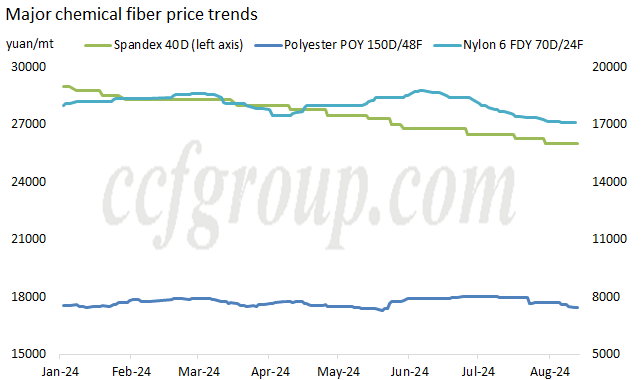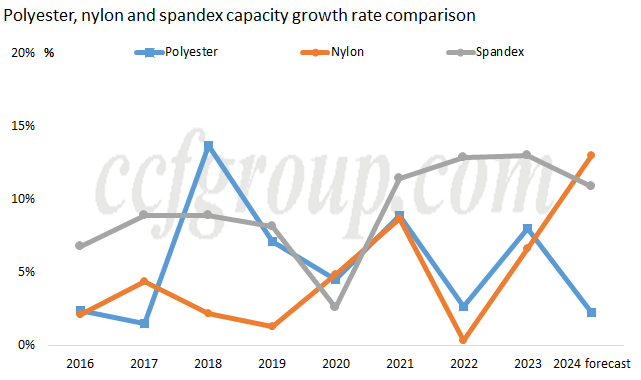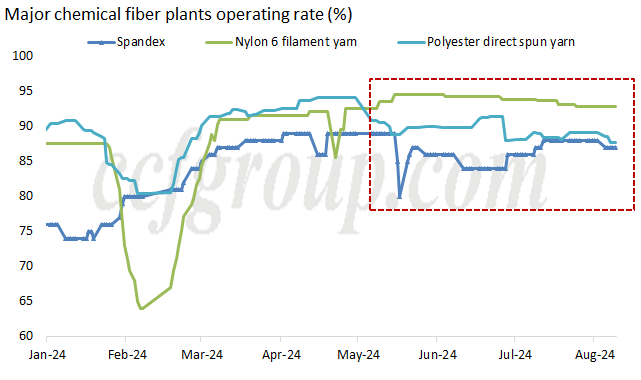What's the weakness in spandex compared to polyester and nylon?
Since the beginning of the year, the trends of the main raw materials for synthetic fibers-polyester, nylon, and spandex-have shown significant discrepancies. The prices of polyester and nylon have experienced wide fluctuations influenced by supply and demand, seasonal changes, and cost variations. However, spandex market continues to experience severe competition, with prices consistently falling.

Since the beginning of the year, the price trends of polyester, nylon, and spandex have shown clear differences, though some similarities exist. All three materials have experienced price declines, with spandex prices decreasing more sharply than those of polyester and nylon (see above chart). The price declines for polyester, nylon, and spandex since the beginning of the year are approximately 1.8%, 5.0%, and 10.3%, respectively. Notably, the price performance has diverged among these materials; while polyester and nylon saw two phases of price spikes followed by corrections, spandex has shown a consistent downward trend.
Early in the year, polyester prices experienced a slight spike, and by late February and early March, prices were at a seasonal high. In March, due to downstream inventory digestion and insufficient new order follow-ups, the average monthly price of polyester saw a slight decline. From April to mid-May, polyester prices continued to soften; however, by late May, major polyester manufacturers began to limit production to maintain prices, leading to a noticeable increase in June's average monthly price.
Meanwhile, nylon prices rebounded slightly in April and May due to demand from sun protection, sports, leisure, and outdoor sectors. However, despite a reduction in new orders for circular knitting machines and warp knitting in early June, strong cost support from rising benzene prices led to a slight increase in nylon prices. Prices of nylon filament dropped in mid to late June due to weakened demand. In July, polyester and nylon prices slightly fell as downstream weaving operating rates decreased and demand softened in the deep season, alongside cost collapses.
Since the beginning of the year, spandex prices have followed a continuous downward trend, reaching historic lows and lacking effective rebounds, with evident competition among brands.
| Price unit: yuan/mt | Polyester POY 150D/48F | Nylon 6 FDY 70D/24F | Spandex 40D |
| Highest | 8,015 | 18,800 | 29,000 |
| Lowest | 7,295 | 17,100 | 26,000 |
| 2024-01-02 | 7,580 | 18,000 | 29,000 |
| 2024-08-12 | 7,440 | 17,100 | 26,000 |
| Change | -140 | -900 | -3,000 |
| Change rate | -1.80% | -5.00% | -10.30% |
From the perspective of supply and demand fundamentals, the supply-demand situation for polyester and nylon is better than that for spandex this year. Although the growth rate of spandex production capacity in Chinese mainland is expected to slow down in 2024, it is still anticipated to grow around 11%. In contrast, the expected growth rates for polyester and nylon production are 2.2% and 13.0%, respectively. Polyester has the least new production capacity added this year, while nylon filament's new capacity is concentrated from September to November.
Following the high boom period in 2021, the average capacity growth rate for the spandex industry over the past four years is about 12.1%, and industry demand has struggled to keep pace with the growth rate of supply. In contrast, the average growth rates for polyester and nylon over the past four years are expected to be at 5.5% and 7.2%, respectively, indicating that the growth of spandex capacity exceeds that of polyester and nylon (see below chart).

As for the operating rates of polyester, nylon, and spandex (see below chart), from January to April this year, the average operating rate of the polyester industry was the highest among the three. Since May, the average operating rate of the nylon industry has been the highest. In contrast, the operating rate of spandex has continuously remained the lowest. The average operating rates for polyester, nylon, and spandex since the beginning of the year stand at 89.6%, 89.5%, and 84.8%, respectively, all of which have improved year-on-year by 11%, 9.9%, and 5.0%.

From the cost perspective, there are also differences in the trends of the main raw materials for polyester, nylon, and spandex this year. The main raw materials for polyester and nylon, such as PTA, MEG, and CPL, are closely related to macroeconomic factors and crude oil products, resulting in wide fluctuations. Conversely, the main raw material for spandex, PTMEG, has seen a consistent downward trend due to an oversupply from newly released production capacity, leading to a significant cost collapse, which in turn has negatively affected the price performance of spandex.
In summary, since the beginning of the year, spandex has been underperforming compared to polyester and nylon in terms of synthetic raw materials. This is partly due to the weak performance of the main material PTMEG, and also closely related to rapid industry expansion post the high boom period. The aftereffects of the price spiral increase in 2021 continue to linger, and since the beginning of 2024, internal competition within the industry has intensified. Although prices have been adjusted downwards for several years, the overall performance still reflects a downward spiral trend.
- Top keywords
- Cotton Price
- Cotton Futures Price
- Cotton Futures
- CZCE
- PTA Futures Price
- Chemical Fiber
- Polyester Prices
- Wool price
- PTA Futures
- Shengze Silk
- China
- Yarn Price
- price
- China Textile City
- Fibre Price
- Benzene Price
- Cotton
- Index
- Cotton Index
- PTA
- fabric price
- NYMEX
- Top 10
- textile industry
- Spot Cotton
- Cotton Yarn
- Polyester Price
- Futures
- PTA Price
- cotton yarn price

